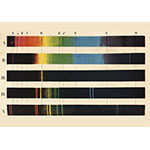Result of the decomposition of a ray of sunlight into its component primary colors. The simplest method is to project the ray onto a prism, which refracts it, breaking it down into its primary components; if these are captured on a white screen, a band of different colors and variable intensity appears. In 1655, in a series of fundamental experiments with a prism, Isaac Newton (1642-1727) demonstrated that white light is not an elementary substance, but a mixture of different colors.
Related objects








